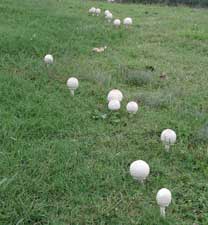Resource Library
Plant of the Week: Fairyring
The University of Arkansas System Division of Agriculture does not promote, support or recommend plants featured in "Plant of the Week." Please consult your local Extension office for plants suitable for your region.
Plant of the Week
Fairyring
Latin: Chlorophyllum molybdites

After a hot and dry summer, the rains finally returned recently. For many areas, the rains have invigorated and revived a tired and thirsty landscape.
Not only did the plants revive, but so did the mushrooms which magically appeared in lawns and flower beds. Many of these made their appearance in fairy rings.
Most biologists no longer consider mushrooms a part of the plant kingdom, instead assigning them their own branch on the tree of life. But, because they make their appearance in the lawn, I consider them fair game for this column.
Fair rings result from the outward growth of mycelium (the vegetative body of a mushroom colony), which originally started growing on a piece of underground organic matter such as a dead tree stump or root. As the organic matter decays, mycelial strands begin to radiate outwards.
If the soil is of uniform tilth and moisture - such as you usually find in lawns - the resulting fairy ring may be a complete circle. But if there is some impediment to mycelial spread, only a portion of the circle's circumference will remain. These partial, often eye-brow shaped remnants, are more common than full circles.
This process of decay and underground expansion does not go without notice in the lawn.
Usually, grass inside the fairy ring is less vigorous than the rest of the lawn, sometimes browning out because the mycelial mat is so dense roots can't get the water they need. The outer extremity of the fairy ring mycelium is nutrient rich, especially in nitrogen, so the grass there will be greener and taller than the rest of the lawn.
About any kind of mushroom can grow in a fairy ring. All fairy ring mushrooms should be considered poisonous unless their identity is confirmed by someone knowledgeable in the finer points of mushroom recognition.
The meadow mushroom (Agaricus campestris) is edible and the herbalist Gerard, in the 1633 edition of his book, presented this little couplet "the meadow mushrooms are in kinde the best, it is ill trusting any of the rest." But he goes on to caution people not to eat any mushrooms saying "few of them are good to be eaten, and most of them do suffocate and strangle the eater." It's good advice because one of the look-alike species is the highly toxic destroying angel (Amanita virosa).
Superstitions surrounding fairies and fairy rings - the principle one being that it was unlucky, even to the point of death - to step inside the ring formed by the dancing feet of the wee ones didn't seem to survive in the New World. Lots of others did - the one about black cats, going under ladders, broken mirrors, etc. - but not this one.
The current revival of interest in fairies amongst some New-Agers probably has more to do with Disney Productions than old Druid traditions, but cynics such as me shouldn't be taken as final word on the subject.
Fairy rings can disrupt the carpet-like nature of a lawn, but they do no lasting damage to the turf. Running an aerator through the mycelial matt and extra fertilizer and water within the ring area can disguise the differential growth caused by the expansion of the fungus.
By: Gerald Klingaman, retired
Extension Horticulturist - Ornamentals
Extension News - September 29, 2006
The University of Arkansas System Division of Agriculture does not maintain lists of retail outlets where these plants can be purchased. Please check your local nursery or other retail outlets to ask about the availability of these plants for your growing area.